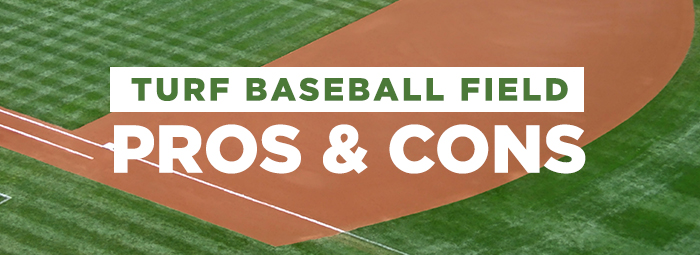
Originally posted on March 30, 2022
Considering installing **artificial turf** on your baseball field? There’s much to consider. If you’re worried about whether synthetic grass is a hit or miss for baseball, let Turf Factory Direct calm those nerves. You’ll receive the full scoop on the pros, cons, and everything in between, helping you hit a home run instead of striking out. Why stop reading now when you’re on the verge of finding tips that could transform your field?
What is artificial turf?
Artificial turf is a type of field covering that simulates and replicates the feeling, texture, and softness of real grass. Most artificial turf consists of a leveling base layer that has the turf fibers installed over top, finally finished with a sand or crumb rubber infill to act as a ballast for the turf fibers, as well as make the surface softer and easier to walk on.
The 6 Benefits of Artificial Turf
Artificial turf baseball fields that have been properly installed and well maintained have many benefits compared to a natural grass baseball field.
1) Turf Baseball Fields Withstand More Playing Time
With artificial turf sports fields, it’s completely possible to play year round, especially in a covered stadium. Many players report that playing baseball on turf is just like playing on natural grass, and some players prefer turf. Because of its artificial nature, turf is durable and can withstand heavy use.
An artificial turf field can be played on for more than 3,000 hours per year on average, without necessary resting time. Managers recommend against using a natural grass field for more than 20 – 24 hours per week, or 680 – 816 hours per year, for a three-season window.
These estimates also take into account winter seasons, rain, and other natural occurrences. Turf doesn’t require maintenance and care to keep from dying in the winter, nor does it need special care and treatment to be protected from rain, snow, and other inclement weather issues.
2) Turf Baseball Fields Are Ready for Play
Artificial turf has a shorter installation and preparation time compared to the time to seed and tend a grass baseball field. You’re unable to walk on natural grass for a minimum of 4 weeks after seeding. Turf can be ready for the big game immediately after installation.
3) Turf Baseball Fields are Chemical-Free & Safe
Turf is safer for kids, pets, and athletes than natural grass for a few reasons. Natural grass maintenance includes using chemicals, such as fertilizers, pesticides, and herbicides, that are harmful to people and animals. Turf stays green and lush year-round, regardless of climate, without the use of chemicals.
Additionally, grass can become a slippery, abrasive, and inconsistent surface that causes falls and injuries. Artificial turf is non-abrasive, shock-absorbent, non-toxic, and provides traction. This means athletes are less likely to trip and fall, and less likely to be injured if they do fall.
4) Turf Baseball Fields Save Water
Unlike grass, turf baseball fields are drought-resistant, and can save water that would be wasted being spent to keep grass green and lush. Beyond the regular light cleaning effort, or misting in hot climates to keep the turf cool, turf does not require any water to maintain. This means its cost is dramatically reduced when compared to caring for a green grass baseball field.
5) Turf Baseball Fields Are Low Maintenance
Artificial turf is incredibly low maintenance. Beyond the occasional top off on infill, regular cleaning, and occasional repairs, costs for a professional field can come in at around $5000 per year, and with regular maintenance, artificial turf can have a lifespan of 20 years with minimal repairs and replacement.
6) Turf Baseball Fields Are Cost-Effective
Turf is incredibly cost-effective when compared to grass. While its initial installation costs are higher, over time, the amount of hours that a turf field can be used and how easily and cheaply it can be maintained results in massive savings.
While the cost of a turf football field is comparable to that of a turf baseball field, the latter is usually a lower number. An artificial turf baseball field typically has a base cost of between $400,000-700,000. Artificial turf baseball fields maintenance costs around $5,000 a year. That cost is much lower compared to the $20,000 a year to maintain natural grass.
The Single Downside of Artificial Turf
Some baseball and landscaping professionals will say that there are only a few downsides to artificial turf. One of them being the higher upfront cost to install turf compared to seed grass. But that is offset by the lower maintenance costs.
The only real downside to turf baseball fields is the issue of heat retention in hot climates, which is easily remedied by giving the turf a spray down with water, and using a cooling infill.
Aside from that, there is a negative stigma surrounding turf being less attractive. This was likely due to the technology being in its infancy years ago. Modern artificial turf technologies are almost unrecognizable when compared to ones a decade or two ago, making turf the attractive, durable, low-glare, and low-maintenance sports and landscaping surface it is today.
Turf Factory Direct: Your Artificial Turf Experts
If you’re looking to install an artificial turf field, look no further than Turf Factory Direct. We’re your one-stop shop for all things artificial turf. Our friendly staff is available to help you make the right decision when it comes to building a baseball field. Get in touch with us or start browsing our products today.








